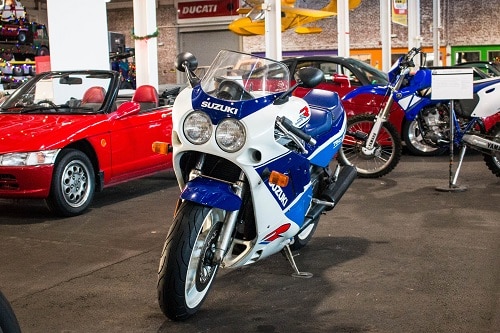
Suzuki GSXR750- 1988
The mid-1980s saw the beginning of the “bullet” bike. Suzuki took three models of race bikes and de-tuned them for sale to the public. The demand was substantial–the motorcycle...
DAILY DEMONSTRATIONS AT 11AM, FREE WITH ADMISSION!
Please note that the cars or exhibit items shown in this database are part of our collection but may not be on display when you visit.
The mid-1980s saw the beginning of the “bullet” bike. Suzuki took three models of race bikes and de-tuned them for sale to the public. The demand was substantial–the motorcycle...
In 1952, disabled Russian veterans of World War II (or the “Great Patriotic War” as it was called in the USSR) received their long overdue motorized transportation in the...
The Tatra T-11 was the first car made entirely by Tatra in 1923. The T-11 was famous for its robust and innovative designs which featured an air-cooled engine...
Hans Ledwinka was one of the most original and logical thinkers ever to work in the motor industry. He believed the automobile was destined to become an object...
In 1925 Tatra decided to enter the famous Targa Florio road race in Italy to help publicize its name. Since Tatra had only been making cars for two...
Developed with the intent to offer a commercial vehicle with as low cost as possible, Tatra introduced the three-wheeled T-49 in 1930. There were two options available: a one-person...
In 1931, Tatra introduced the T-57 model, with the air-cooled, four cylinder, overhead valve engine placed in front. The T-57 was one of Tatra’s most popular models – four...
In 1931, Tatra introduced the T-57 model, with the air-cooled, four cylinder, overhead valve engine placed in the front. The T-57 was one of Tatra’s most popular models–four series...
In 1931, Tatra introduced the T-57 model, with air-cooled, 4 cylinder, overhead valve engines placed in the front. The T-57 was one of Tatra’s most popular models and remained...
After World War II, Tatra found itself stranded behind the Iron Curtain. Hans Ledwinka was accused of collaborating with the Nazis and was imprisoned from 1945-51. The T-600...
After World War II, Tatra found itself stranded behind the Iron Curtain. Hans Ledwinka was accused of collaborating with the Nazis and was imprisoned from 1945-51. The T-600 was...
When the Czech Republic was formed, the centralized planned economy appointed Tatra to be the manufacturer for big automobiles (those cars with engine displacement over 2000cc). It was then...
The T602 Tatraplán Sport was created by Tatra for the 1949 Czechoslovak Grand Prix. It was based on the T600 Tatraplán, which was a continuation of the pre-WWII T77...
Tatra began as a Czechoslovakian car maker in 1922 and has been one of the largest auto makers behind the Iron Curtain. You can find additional history and a...
In the late 1960s, it became time to start work on the design of a new Tatra to take over the role of flagship for the Communist officials. The...
The Vignale-designed Tatra 613 was introduced in 1975, and was too primitive to attract Western buyers after the fall of Communism across Europe in the late 1980s-early 1990s. Tatra...